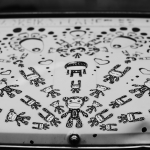When the days are short in winter and the hours of sunshine are few and far between, many people suffer from low mood and listlessness. Light therapy with a daylight lamp can often help to dispel depressive moods. So next time you enjoy your time at https://blog.vave.com/ switch on your daylight lamp.
WHY TRYING?
Bad weather and shorter days – a lack of light can lead to depressive moods or to autumn depression or winter depression. It is important to counteract the lack of light during this time and get as much daylight as possible. However, if the sun barely shows itself, going for a walk is sometimes not enough. In this case, light therapy with a daylight lamp can help.
HOW DOES IT WORK?
It is not always enough to switch on the daylight lamp to combat depressive moods – but it can help. The lack of light in winter upsets the balance of melatonin and serotonin in our bodies. These two hormones control our internal clock.
Melatonin ensures that we can sleep and is released when there is a lack of light. Serotonin, on the other hand, helps us to wake up in the morning and is released when light is present. Serotonin also acts as the body’s antidepressant. In the dark winter months, a serotonin deficiency can quickly occur – we feel tired, listless, listless, and melancholy.
A daylight lamp stimulates the body to release more serotonin and produce less melatonin. Studies have shown that light therapy with a daylight lamp can be very effective in treating depressive moods. In contrast to treatment with dietary supplements or medication, light therapy has hardly any undesirable side effects.
Lumen, lux, kelvin, and watt
Various units are used to provide information on daylight lamps and normal light bulbs. Here is an overview to help you find your way around and understand what each unit means:
- Lumen is the unit for luminous flux. In other words, it indicates how much light a lamp emits. The higher the value, the brighter the lamp.
- Lux is the illuminance. The value indicates how strongly an area is illuminated, usually, the standard value here is 1 square meter.
- Kelvin describes the color temperature. The lower the number, the warmer the light. The values for daylight lamps are around 5,500 Kelvin.
- Watt The wattage indicates how much energy is required for the lamp or light bulb to light up.
- How daylight lamps work
- Daylight lamps vary in size and are often organically shaped lamps. Sometimes they look like a sculpture. You can place them on your desk, for example.
- The lamps emit daylight over a large area. They are called daylight because the color of the light emitted is closest to our midday sun. A UV filter is built into the lamps so that only the healthy spectrum of daylight reaches our retina.
Important: A daylight lamp that is to be used for light therapy against depressive moods should have at least 2,500 lux to 10,000 lux.
Seek medical advice before light therapy. You should seek medical advice before starting light therapy.
Light therapy generally has a positive effect on mood, even in people who are not depressed. However, you should clarify a few things before deciding on light therapy:
Depressive moods can be triggered by more than just a lack of light. Some illnesses can be the cause. These include hypothyroidism, hypoglycemia, viral diseases, or chronic fatigue. Light therapy with a daylight lamp will not help with these illnesses. You should therefore seek medical advice beforehand and make sure that your low mood is not caused by one of these or another illness.
In certain cases, light therapy should only be used with caution or not at all. This applies above all to existing eye diseases. There are also preparations, such as St. John’s wort or psychotropic drugs, whose effects are enhanced by light. Always seek medical advice in this regard.
THE CORRECT USE
Bad weather and short days: We often don’t get enough daylight in winter. A daylight lamp provides between 5,000 and 30,000 hours of light. With normal use, it will therefore last for many years. Light therapy is also about getting the day-night rhythm back into balance.
From 10,000 lux, half an hour a day in front of the lamp is sufficient. If the lamp is not quite as bright, more time is needed. For most people, the best time for light therapy is in the morning.
Tip: Despite the recommendation, pay attention to your rhythm and don’t force an artificial one on yourself. Find out which chronotype you are most likely to be. This may give you a better idea of when light therapy fits best into your day. This could also be in the evening. However, if you have difficulty falling asleep afterward, an earlier time is more suitable.
You can have breakfast, read, work, or simply meditate during your daily light therapy. The only important thing is the following:
Sit about half a meter in front of the fluorescent screen and keep your eyes open.
You don’t have to look at the lamp all the time, it’s enough if you turn towards it from time to time.





